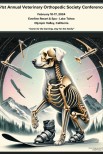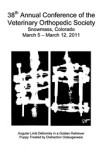Abstract
OBJECTIVE: To define a safe corridor in the dorsal plane relative to the articular surface for placement of a single screw in lag fashion to achieve stabilization of sacroiliac luxation in the dog. Study Design: Cadaveric study.
METHODS: Dorsoventral radiographs of denuded canine sacra (n=49) were taken to determine the safe corridor in the craniocaudal plane, and the maximum, optimum and minimum angles were calculated that would allow a screw inserted in lag fashion to engage at least 60% of the width of the sacral body without cranial or caudal penetration through the bone.
RESULTS: The mean safe corridor in the dorsal plane is ∼24° wide. Mean craniocaudal minimum, optimum and maximum drill angles from the drill start point were 88°, 100°, and 111° from the articular surface, respectively. No single angle will completely avoid risk of screw penetration beyond the safe corridor cranially and caudally.
CONCLUSIONS: There is sufficient anatomic variation between different canine sacra that a single angle cannot be recommended for screw placement in the dorsal plane.
Canine sacroiliac luxation: anatomic study of the craniocaudal articular surface angulation of the sacrum to define a safe corridor in the dorsal plane for placement of screws used for fixation in lag fashion.
Date
2011 Jan
Journal
Vet Surg
Volume
40
Number
1
Pages
22-6









